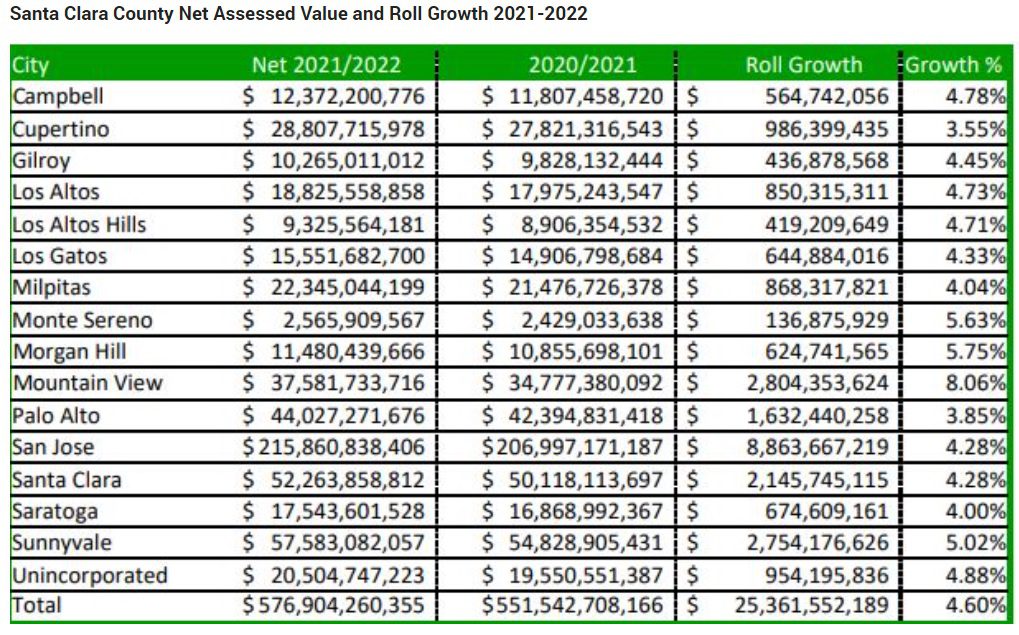The value of taxable properties in Santa Clara County rose by 4.6% since last year—showing that the pandemic’s economic impact had a limited reach.
“This was not a normal business cycle,” Santa Clara County Assessor Larry Stone told San José Spotlight. “This was a self-imposed recession, based upon the health crisis.”
The total value of real and business property in the county is $576.9 billion, according to a news release issued by the county last week.
The county’s assessment roll, which contains about 550,000 properties ranging from boats and airplanes to commercial buildings, is revalued every year based on the prior year’s assessment, Stone said.
California’s Prop. 13, passed by voters in 1978, limits the growth of a property’s assessed value to no more than 2% per year. A property is not formally reassessed until it changes owners or if new construction is completed.
For example, a property valued at $2 million last year will see an increase of no more than $40,000 this year, as long as no new construction on the property occurs.
The law also limits the base amount of each county’s property tax to 1%, meaning that a $2 million property faces a maximum of $20,000 for the basic tax. Property owners are taxed an additional amount to pay voter-approved debts, such as municipal or school bonds.
Stone said the majority of the assessment roll growth from this last year came from new construction. San Jose added nearly $8.9 billion to the county’s assessment roll, while Mountain View and Sunnyvale each added more than $2 billion.

The rise in value of taxable properties means local governments shouldn’t require any tax increases this year, according to Pierluigi Oliverio, San Jose planning commissioner and board member of the Silicon Valley Taxpayers Association.
“They’re receiving a consistently exceeding amount every year of new tax revenue,” Oliverio said, adding that the county’s assessment roll increased by 14% since 2018. “They’ve received more than enough money.”
The assessment roll increased at a higher rate than projected earlier this year, according to the county’s recommended budget for 2021-22. Santa Clara County projected that the assessment roll would grow to $572.1 billion, meaning an additional $4.8 billion remains to be taxed this year.
That amounts to more discretionary funds in county coffers, said Bob Brownstein, strategic advisor at Working Partnerships USA.
Discretionary funds can be used for a variety of purposes, such as when Santa Clara County purchased O’Connor and St. Louise hospitals in 2019. However, a bump in property tax revenues doesn’t mean the county is in the clear financially.
“You also have to look at what’s happening in terms of expenditures… are there new things that the jurisdiction has to do? Are there things that it was doing in the past that cost more?” Brownstein said. “You have to look at all of these things together to see what the whole picture is.”
Oliverio said the county should try to help business owners affected by the pandemic, as it’s the governing body that closed businesses in the first place.
“They should have a responsibility in being proactive and making sure that there’s a way to defer payment or a payment plan, whatever needs to be done for those properties that contain commercial businesses that were closed,” he said.
Santa Clara County is taking a second look at commercial and business properties to help owners whose operations may have shuttered during the pandemic, Stone said. For example, the county is asking restaurant owners how long their businesses were closed and whether or not they offered take-out options.
“We are trying to get ahead of this, in addressing warranted declines in value as a result of COVID and the impact it’s had on commercial property… and trying to make those adjustments, rather than wait for property owners to file an assessment appeal,” Stone said.
Property owners can file an assessment appeal if they feel the assessed value of their properties is higher than market value. Stone said the county normally receives about 3,000 appeals per year.
“When property values drop, we get more assessment appeals,” Stone said, adding that he expects a higher than average number of appeals this year.
The deadline for filing assessment appeals is Sept. 15. Taxpayers can also call or file an informal review online before Aug. 1—the deadline for making valuation adjustments before tax bills are mailed.
“We’ll do as many informal reviews as we have time for before the first of August,” Stone said. “We’re trying to get out in front of the problem, and make reductions where warranted, so the tax bill that’s mailed in October is accurate.”
Contact Sonya Herrera at [email protected] or follow @SMHsoftware on Twitter.



Leave a Reply
You must be logged in to post a comment.